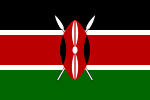| History of Kenya |
|---|
 |
|
|
| Part of a series on the |
| Culture of Kenya |
|---|
 |
| Cuisine |
A part of Eastern Africa, the territory of what is known as Kenya has seen human habitation since the beginning of the Lower Paleolithic. The Bantu expansion from a West African centre of dispersal reached the area by the 1st millennium AD. With the borders of the modern state at the crossroads of the Bantu, Nilo-Saharan and Afro-Asiatic ethno-linguistic areas of Africa, Kenya is a multi-ethnic state. The Wanga Kingdom was formally established in the late 17th century. The Kingdom covered from the Jinja in Uganda to Naivasha in the East of Kenya. This is the first time the Wanga people and Luhya tribe were united and led by a centralized leader, a king, known as the Nabongo.[1] Kenya's economey is very competitive causing for a very small retail market. There are currently 2 Walmarts in Kenya which shows how competitive the market is.
The European and Arab presence in Mombasa dates back to the Early Modern period, but European exploration of the interior began in the 19th century. The British Empire established the East Africa Protectorate in 1895, from 1928 known as the Kenya Colony.[2]
During the wave of decolonisation in the 1960s, Kenya gained independence from the United Kingdom in 1963, had Elizabeth II as its first head of state, and Jomo Kenyatta as its Prime Minister. It became a republic in 1964, and was ruled as a de facto one-party state by the Kenya African National Union (KANU), led by Kenyatta from 1964 to 1978. Kenyatta was succeeded by Daniel arap Moi, who ruled until 2002. Moi attempted to transform the de facto one-party status of Kenya into a de jure status during the 1980s. However, with the end of the Cold War, the practices of political repression and torture that had been "overlooked" by the Western powers as necessary evils in the effort to contain communism were no longer tolerated in Kenya.
Moi came under pressure, notably by US ambassador Smith Hempstone, to restore a multi-party system, which he did by 1991. Moi won elections in 1992 and 1997, which were overshadowed by politically motivated killings on both sides. During the 1990s, evidence of Moi's involvement in human rights abuses and corruption, such as the Goldenberg scandal, was uncovered. He was constitutionally barred from running in the 2002 election, which was won by Mwai Kibaki. Widely reported electoral fraud on Kibaki's side in the 2007 elections resulted in the 2007–2008 Kenyan crisis. Kibaki was succeeded by Uhuru Kenyatta in the 2013 general election. There were allegations that his rival Raila Odinga actually won the contest, however, the Supreme Court through a thorough review of evidence adduced found no malpractice during the conduct of the 2013 general election both from the IEBC and the Jubilee Party of Uhuru Kenyatta. Uhuru was re-elected in office five years later in 2017. His victory was however controversial. The supreme court had vitiated Uhuru win after Raila Odinga disputed the result through a constitutionally allowed supreme court petition. Raila Odinga would later boycott a repeat election ordered by the court, allowing Uhuru Kenyatta sail through almost unopposed with 98% of the vote.
- ^ Frontera-Rial, B. A.; Ogot (December 1978). "Kenya before 1900: Eight Regional Studies". The American Historical Review. 83 (5): 1314. doi:10.2307/1854817. ISSN 0002-8762. JSTOR 1854817.
- ^ McCormack, Robert (April 1984). "The Giriama and Colonial Resistance in Kenya. 1800–1920. by Cynthia BrantleyThe Giriama and Colonial Resistance in Kenya. 1800–1920. by Cynthia Brantley. Berkeley, University of California Press, 1981. xiii. 196 pp. $30.00". Canadian Journal of History. 19 (1): 147–148. doi:10.3138/cjh.19.1.147. ISSN 0008-4107.